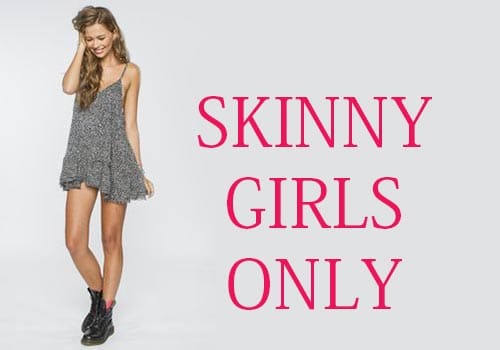The Controversy
You may have heard of the notorious size small-only store that started in Italy and expanded its locations to California, Canada, New York City, and the East Coast.
Brandy Melville, a 20-year-old brand, has grown magnetic to teens and twenty-something girls (the Brandy girls) in the U.S. It has a look comparable to Forever 21 with long cotton tops, knits, patterned bottoms, graphic tees, and delicate accessories—cute, with an obvious allure for girls who wear the clothes, but marked with an unwritten “Do Not Enter” sign for girls who can’t fit the clothing.
The clothes at BM are either labeled “small” or “one size.” According to the brand’s website, under their description for sizing, “Most of Brandy Melville’s clothing is one size. We provide measurements for most items to help you get a better idea of the fit. Some of our bottoms have Italian sizing.” It then goes on to list the American equivalents of 00, 0, 1, 3, and 5 for bottoms.
According to the Huffington Post, “To be able to shimmy into Brandy Melville’s only size of skinny jeans, a girl would need to have a 25-inch waist — that’s around a size 0 or 2, depending on the brand.” The Post then goes on to say that the average American 16-year-old girl is approximately 5 ft. 3”, weighs about 138 pounds, and has around a 31-inch waist—6 inches off from the Disney princess-like waist of a Brandy girl.
Now, there is nothing wrong with being young and thin—if that is what you are. You have to wonder, though, if “young and thin” (with waves of long, beachy hair and elongated legs) is the image that girls who shop primarily Brandy are striving to attain and maintain. Is “young and thin” what equates as “beautiful” in a Brandy Melville shopper’s mind?
Racked.com also notes the mostly white demographic that overwhelms the brand’s advertising, which is quickly recognizable on both the BM website and Instagram. The Brandy girl is fun, carefree, and likely popular – suggestive in many ways of the all-American girl living the all-American dream. The questions become much like a scrutiny of modern-day Barbie—we see her trailing to work, to the Oval office, to family picnics, to a Malibu beach house looking stylish and effortless, standing with her stilettos and 18-inch waist. She is fun, carefree, well-liked, and has it all—but could she be all these things, if she wasn’t so young and so thin?
The Fans
On the one hand, there are girls who see the Brandy stores as the ultimate experience in convenient shopping. These girls revel in the fact that not having another size to try on makes it easy; you don’t complicate shopping by dreadfully rummaging through racks for sizes.
The company has even been credited with offering promising opportunities for young women through the use of social media, ladies who otherwise would not have expected to land such business ventures. One example is 15-year-old Emma Simms, who recounted her positive experience with Brandy Melville earlier this year. She said she was recruited to Brandy Melville because of photos she would stage with her friends on Instagram that tagged the company’s name.
Another is 24-year-old Alex Centomo, who launched a full-time Youtube career (and has over 100,000 subscribers) through her interaction with BM. She said that they really loved her long hair look and wanted to promote her more, Melville being what “definitely got [her] started.”
The Critics
On the other side of the spectrum are critics who say that the Melville company encourages body dysmorphia. In a riveting University of Southern California post by editorial director Rini Sampath, sophomore Sampath discounted the “one size fits most” signs that are displayed in Melville stores.
She noted how companies like Forever 21 and H&M recently listened to consumers who voiced a desire for sizes above size 12.
Wrote Sampath, “But consumers have the power to stop such companies from perpetuating negative body image, no matter their size or shape. Asking [Melville] to remove these signs is the first step in battling such distasteful choices.”
To skeptics of the BM brand, creating a store that is size small-only is not the same as creating a plus-size only brand for specific groups of consumers. It is damaging to positive body image proponents and an act of exclusion through business.
The Weigh In
Smiling, pretty, and enjoying life while wearing a label of clothes—a Brandy girl may not be a criminal, but her image is perpetuated on the BM Instagram of over 2 million followers, sending out messages about beauty that to many people, are unjustifiable.
In an October 17 post, BM visual manager Sairlight Saller stated, “I don’t think it causes a negative effect on the body image of any one of our shoppers because anyone can come in the store and find something.” To 18-year-old fashion-lover Lani Renaldo, who posted an open letter to BM in March, the only “something” she can find from the company are “sweaters, long skirts, and tank tops”—and she feels sure that she is not the only one.
Even for girls who describe themselves as naturally petite, a top like the Nicoleta is difficult to imagine squeezing into. Several other midriff-baring tops are also on the BM website, including the Giselle top and the Paloma tank, making you question exactly how the clothes are “supposed to” hang on the girl wearing it, let alone what size a young woman must be to fit the look.
Visit the BM Instagram and Brandy Melville USA to judge for yourself. Or, check out these other resources:
A Brandy Melville photo shoot (behind the scenes with BM girls)
Celebrities who wear Brandy Melville
Take the poll: Is Brandy Melville Harmful to Female Body Image?




